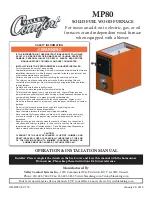
18-CD30D1-12
15
Installer’s Guide
GENERAL VENTING INFORMATION
THIS FURNACE MUST BE VENTED TO THE
OUTDOORS. THESE FURNACES ARE INDUCED
DRAFT VENTED AND MUST
NOT
BE CONNECTED TO
ANY VENT SERVING ANOTHER APPLIANCE. PLEASE
NOTE THAT THESE FURNACES USE
POSITIVE-
PRESSURE
VENT SYSTEMS.
▲
WARNING
!
CARBON MONOXIDE HAZARD
FURNACE MUST BE VENTED PROPERLY.
FAILURE TO FOLLOW THIS WARNING COULD
RESULT IN CARBON MONOXIDE, FIRE OR SMOKE
THAT CAN CAUSE SERIOUS BODILY INJURY, DEATH
OR PROPERTY DAMAGE.
IMPORTANT
:
The building owner/maintenance provider must keep
the area around the vent clear from snow.
Proper venting is essential to obtain maximum efficiency
from a condensing furnace. Proper installation of the
vent system is necessary to assure drainage of the
condensate and prevent deterioration of the vent system.
American Gas Association has certified the design of
condensing Furnaces for a minimum of 0" clearance from
combustible materials with a single wall plastic vent pipe.
See Table 8.
The recommended system is assembled from 2", 2-1/2",
or 3" plastic pipe and fittings (See Table 9, page 18) for
material specifications. Where the system is routed
to the outdoors through an existing masonry chimney
containing flue products from another gas appliance, or
where required by local codes, then 3" venting of Type
29-4C stainless steel must be used in place of PVC
material.
These furnaces have been classified as CATEGORY IV
Furnaces in accordance with ANSI Z21.47 “latest edition”
standards. Category IV Furnaces operate with positive
vent pressure and with a vent gas temperature less than
140°F. above the dewpoint. These conditions require
special venting systems, which must be gas and water
tight.
NOTE: When an existing furnace is removed from a
venting system serving other gas appliances, the
venting system is likely to be too large to properly vent
the remaining attached appliances.
The following steps shall be followed with each appliance
remaining connected to the common venting system
placed in operation, while the other appliances remaining
connected to the common venting system are not in
operation.
CARBON MONOXIDE POISONING HAZARD
Failure to follow the steps outlined below for each
appliance connected to the venting system being
placed into operation could result in carbon monoxide
poisoning or death.
The following steps shall be followed for each appliance
connected to the venting system being placed into
operation, while all other appliances connected to the
venting system are not in operation:
1. Seal any unused openings in the venting system.
2. Inspect the venting system for proper size and
horizontal pitch, as required in the National Fuel Gas
Code, ANSI Z223.1/NFPA 54 or the CSA B149.1
Natural Gas and Propane Installation Code
and these
instructions. Determine that there is no blockage or
restriction, leakage, corrosion and other deficiencies
which could cause an unsafe condition.
3. As far as practical, close all building doors and
windows and all doors between the space in which the
appliance(s) connected to the venting system are
located and other deficiencies which could cause an
unsafe condition.
4. Close fireplace dampers.
5. Turn on clothes dryers and any appliance not
connected to the venting system. Turn on any exhaust
fans, such as range hoods and bathroom exhausts, so
they are operating at maximum speed. Do not operate
a summer exhaust fan.
6. Follow the lighting instructions. Place the appliance
being inspected into operation. Adjust the thermostat
so appliance is operating continuously.
7. Test for spillage from draft hood equipped appliances
at the draft hood relief opening after 5 minutes of main
burner operation. Use the flame of a match or candle.
8. If improper venting is observed during any of the above
tests, the venting system must be corrected in
accordance with the National Fuel Gas Code,
ANSI Z221.1/NFPA 54 and/or CSA B149.1
Natural
Gas and Propane Installation Code
.
9. After it has been determined that each appliance
connected to the venting system properly vents where
when tested as outlined above, return doors, windows,
exhaust fans, fireplace dampers and any other gas-fired
burning appliance to their previous condition of use.
▲
WARNING
!
FACTORY SUPPLIED
ONLY WITH THE
FOLLOWING MODELS:
ALL 100,000 BTUH
UPFLOW MODELS, ALL
120,000 BTUH UPFLOW
MODELS, AND ALL
DOWNFLOW MODELS
#CPL00938
LABEL
SAYS
"TOP"
STRAIGHT SIDE MUST BE
ON BOTTOM FOR PROPER
CONDENSATE DRAINAGE.
WHEN THE FACTORY SUPPLIED "OFF-SET" (2X3
REDUCING COUPLING) IS USED FOR 3" VENT PIPE
INSTALLATION, MAKE SURE THE MARKING "TOP" IS
LOCATED ON THE TOP SIDE OF THE PIPE.
d















































